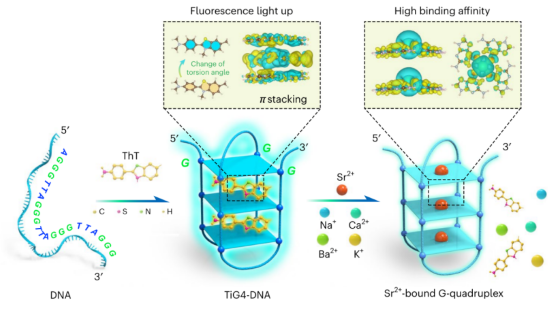近期,海南大学南海海洋资源利用国家重点实验室在国际期刊《Nature Sustainability》发表了题为“Ultrasensitive and highly selective detection of strontium ions”的研究论文,该研究提出了利用DNA结构实现超灵敏和高选择性锶离子检测的方法。
Recently, research fellows of State Key Laboratory of Marine Resources Utilization in South China Sea (MRU) published a research paper entitled “Ultrasensitive and highly selective detection of strontium ions” in the journal Nature Sustainability. The paper proposed a method to achieve ultra-sensitive and highly selective detection of strontium ions using DNA structures.
核能的广泛应用带来了放射性核污染的风险。90Sr是235U的裂变产物之一,也是最常见的放射性核污染元素之一,其半衰期长达28.8年,且化学性质与钙相似,可在食物链和骨骼中积累,并导致骨癌和白血病等疾病。目前,已在土壤、水、食物,甚至生物体内检测到放射性90Sr。考虑到放射性锶对人体生命健康的危害以及其在自然环境中的广泛分布,锶检测对放射性锶污染治理具有重要意义。特别是日本福岛核废水排放,更是加剧了海洋的核污染风险。然而,由于缺乏特征能量射线,90Sr检测仍然是一个挑战。鉴于此,海南大学南海海洋资源利用国家重点实验室王宁和袁益辉团队利用硫黄素T染料触发DNA折叠,形成鸟嘌呤-四联体DNA结构,提出了一种以鸟嘌呤-四联体DNA结构实现超灵敏和高选择性检测Sr2+离子的方法,实现了低至2.11 nM的检测限。该研究开发了一种快速高选择性核污染检测技术,通过监测放射性锶污染在环境中的迁移,可为核电产业的可持续发展做出积极贡献。
The application of nuclear energy inevitably creates the potential risk of nuclear accidents. As a fission product of 235U and a common radioactive element, 90Sr is a radionuclide with a long radiological half-life of 28.8 years. Given 90Sr's similar chemical properties to calcium (Ca), it can accumulate in the food chain and bones of human beings, thus causing bone cancer and leukaemia. Currently, radioactive 90Sr has been detected in soil, water, foods and even in the bodies of biological entities. Considering the harmful effects of radioactive Sr on human health and the wide distribution of Sr in natural environments, the detection of Sr and perhaps its future eradication is of great importance, especially after the recent Fukushima nuclear incident. However, the identification of 90Sr remains a challenge due to the absence of characteristic energy rays signifying its presence. Therefore, Professor Ning Wang and Research Professor Yihui Yuan of MRU create a biosensor that enables the detection of Sr2+ ions in an ultrasensitive and highly selective manner. They take advantage of a fluorogenic dye, thioflavin T, which triggers the folding of DNA to form guanine-quadruplex structures, leading to a detection limit of 2.11 nM. The work could contribute to the sustainability of nuclear power by providing a technological solution to monitor the transportation of radioactive strontium pollution in the environment.

DNA四联体的高选择性锶离子检测原理示意图
Schematic diagram for the Sr2+-ion detection mechanism of TiG4-DNA.
海南大学南海海洋资源利用国家重点实验室为第一完成单位,英国诺森比亚大学和希腊帕特雷大学为合作单位,海南大学南海海洋资源利用国家重点实验室王宁教授和袁益辉研究员为该论文通讯作者。
MRU is the first affiliation, and Northumbria University and University of Patras are the co-affiliations. Ning Wang and Yihui Yuan are the corresponding authors.
该研究获得了国家自然科学基金、海南省重大科技计划等项目的支持。
论文链接:https://doi.org/10.1038/s41893-023-01095-8
The research was supported by the National Natural Science Foundation of China and the Hainan Science and Technology Major Project.
DOI: https://doi.org/10.1038/s41893-023-01095-8
 公众号
公众号